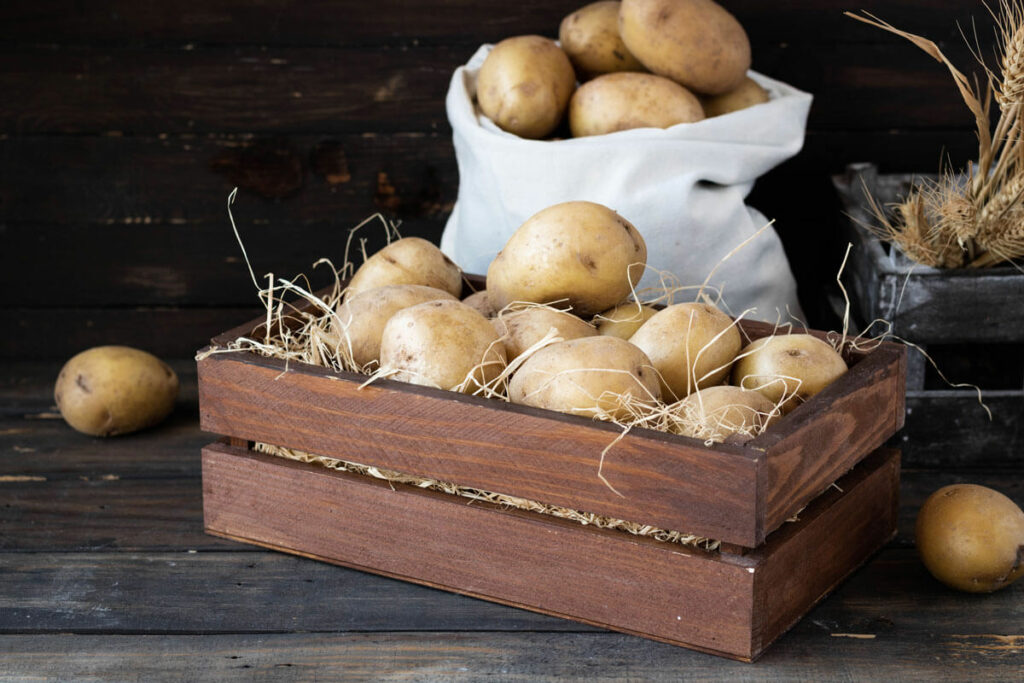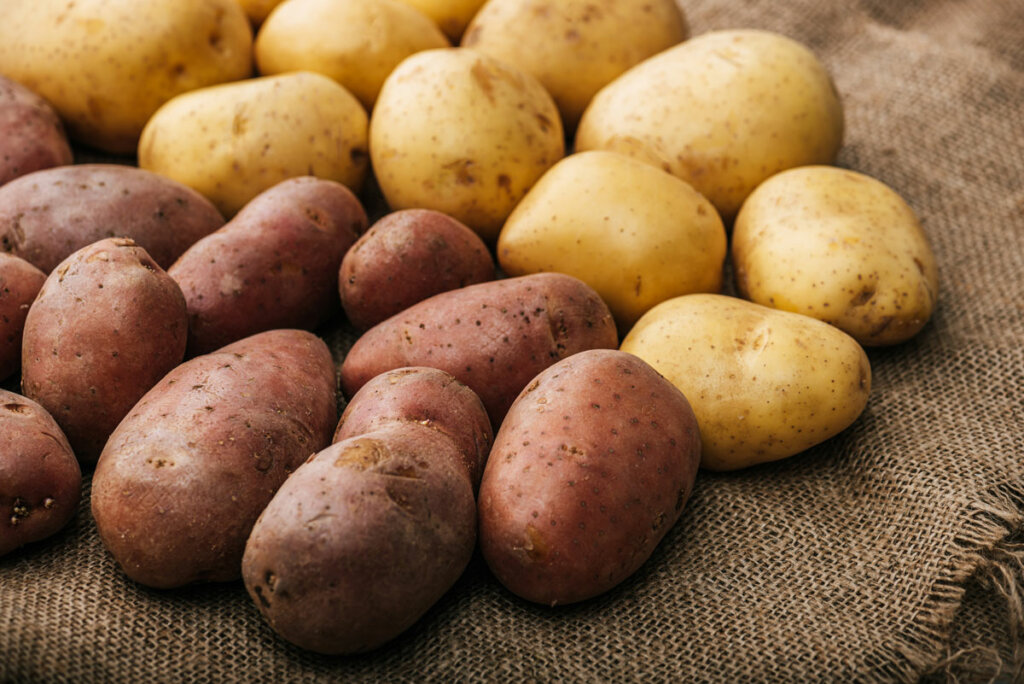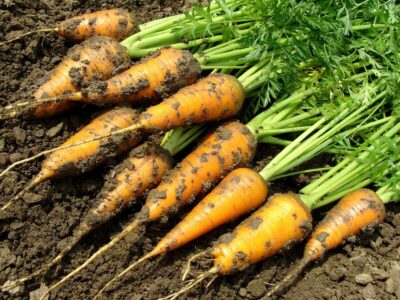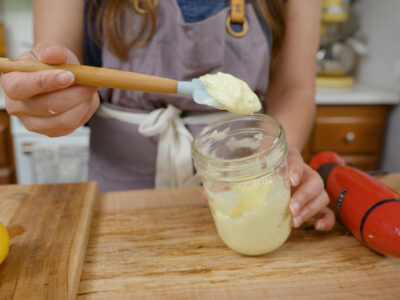When is the best time to harvest potatoes? And what’s the best way for storing potatoes? Keep reading and watch the video below to learn when to harvest, and how to store potatoes both in the ground or indoors.

If you’ve never grown potatoes before, check out this post to learn how to plant and grow potatoes (including methods for growing them in the ground or containers).
With this method, if your weather conditions are right, you can harvest your potatoes as you need them and use the ground as a “root cellar” for long-term storage. This way, you will have potatoes up until the next gardening season!

Table of Contents[Hide][Show]
When to Harvest Potatoes
Take a look at your potato garden. Have any of the plant tops died? This is the first indication that your potatoes are ready for harvest. If you see lots of crispy dried tops, then your potatoes are probably ready for harvest.
However, you can also harvest baby potatoes, or “new potatoes” while the plant tops are still alive. Once the plant dies back, the potatoes won’t continue to grow past the size they already are. But this doesn’t mean you have to harvest them right away!

Use your hand or take a shovel and dig gently around the bottom of the plant to peek at the actual potato. If you don’t see any potatoes by digging, you can also grasp the plant vine, then gently pull up to reveal the potatoes.
If the potatoes are ready (harvestable size), then you can take them out of the ground. If not, and the potato vine hasn’t died, simply push the dirt back over to cover them and allow them to continue growing.

How do you store potatoes and how long do they last?
There are three options for storing potatoes: In a root cellar (or cool dark place), in the ground, or by preserving them.
- Root Cellar – You can harvest and store potatoes in a root cellar or another cool, dark place, such as a crawl space, basement, or garage. It’s important to keep them away from onions or they’ll sprout much quicker.
- In the Ground – You can store potatoes in the ground with a few simple steps (see below) and keep them there through the winter months (even with snow).
- Preserving – You can, of course, preserve your potatoes by pressure-canning, freeze-drying, freezing, or dehydrating them.
Your potatoes, when stored properly, will last until spring.

Everything Worth Preserving
If you want to store your potatoes by preserving them, check out my book, Everything Worth Preserving, where you can find all the safe and approved recipes for preserving potatoes.
In this book, I discuss crop by crop, every way to safely preserve each one at home, including delicious recipes.

What is the best way to store potatoes at home?
As I mentioned above, if you’re not going to be preserving your potatoes, you can store them inside in cold storage or in the ground. This technique works well with many root vegetables (carrots, beets, turnips, radishes, etc.), but we’ll just be discussing potatoes in this post. There are a couple of different steps for each of these, so be sure to read them below.
Store Potatoes Inside
Follow these steps for storing potatoes inside in a cool, dark space, or in a root cellar.
- Harvest potatoes on a warm day. Do not wash the potatoes, leave them dirty. You can brush off excess dirt, but this is not necessary.
- Cure potatoes. Curing is essential so you don’t get bacteria and excess moisture in your potatoes which will cause them to spoil.
- Place potatoes on cardboard boxes or a screen in a well-ventilated area. Ideally, in a dark space with temperatures between 50-65° F.
- Make sure they are not touching each other. They need plenty of airflow around them.
- Cure potatoes for approximately ten days, ensuring any scabs or knicks in the potato have hardened over.
- Store potatoes in a single layer, ideally with the tubers not touching and either wood shavings or newspaper between each layer. Store in a cool, dark place (or root cellar) with good air circulation and temperatures between 40-45° F and humidity between 85-95%.
Pro Tip: For long-term food storage, make sure there is no light. 40 to 45° F is a great storing temperature. 90% humidity is ideal, even though sometimes it is hard to get this high humidity level in your home during the colder months. You can store potatoes at room temperature, they just won’t last past a month or two. Furthermore, sweet potatoes like a slightly different setting and prefer temperatures between 50-65° F and some humidity.

Storing Potatoes in The Ground
While you can harvest and store all of your potatoes inside, there is a second option. This ‘remain in the ground’ method is a form of root cellaring without actually having a root cellar (or having to DIY one).
If you live in a relatively mild climate with cold temperatures, you can simply leave the potatoes in the garden beds and insulate them well with straw or mulch to protect from freezing temperatures. This works well with many root veggies!
A relatively mild type of climate is defined as having reasonably mild winters. This means not having too many deep frosts or massive amounts of snow (potatoes don’t like the frozen ground).
The key is not to let the potatoes freeze and protect them from the light. Instead of harvesting them all, you can insulate them with straw while they are still in the ground.



Follow these steps for storing potatoes in the ground.
- Buy straw. Look for the straw that does not have an overabundance of seed heads. Seed heads look like the pretty top of the wheat. If the straw has many of these, you risk having a wheat garden next season instead of a potato garden. I prefer not to use hay because it molds fast and has more seeds.
- Mulch. Break up the straw bale and cover the potato plants with four to six inches of straw on top.
- Your potatoes need high humidity, or they will shrivel up. The straw will help retain moisture.
- You can add more later if a frost or a big snowstorm is coming. This will give them an added layer of protection.
- Keep them well-covered. Check on your potato beds throughout the season, ensuring they’re well covered. If any straw has shifted away from the bed, recover with additional straw. Exposure to light will cause them to sprout, which does not allow them to last long. Pro Tip: Have you ever noticed at the grocery store they cover the potatoes with large blankets at night? This is also to keep the potatoes from sprouting!
- Make sure your soil is WELL-draining. This will avoid rot. Lousy drainage and a good snow melt will surely rot your potatoes.
They can stay under this straw until the soil temperature reaches 55-60° F (this is about April for me). Then, even if they have sprouted, you can dig them up and move them.
Pro Tip: It’s always a good idea to crop rotate yearly to mitigate disease issues. Also, if you planted potatoes in a raised bed, keep in mind they may not be as well insulated since they’re above ground. You don’t want to come out to the vegetable garden only to find rotten spuds! No one likes that! If you’re growing root crops in raised beds, this option may not be the best solution for your garden.

How do you store potatoes so they don’t sprout?
Storing potatoes correctly helps prevent them from sprouting before you have a chance to eat them. Keep reading for my best storage tips.
When storing potatoes indoors, keep them in a cool, dark place and DO NOT store them near onions. Onions produce a gas that increases the sprouting factor in potatoes.
You can learn more about which fruits and veggies store well together and which don’t (due to ethylene gas) here.
Furthermore, storing potatoes (like russets, red potatoes, etc.) in storage containers like wooden crates helps with proper airflow. I recommend storing potatoes in a single layer (not touching) with newspaper or wood shavings between each layer.
If your potatoes do start to sprout, you can hang onto them and plant them next year as seed potatoes. If the sprouts start to get too long, simply knock them off. Do watch for any potatoes that start to spoil and remove them so they don’t spoil the whole bunch.

More Posts & Podcasts You May Enjoy
- Your Gardening Questions Answered
- Gardening in October
- How to Preserve Zucchini (plus my favorite fresh zucchini recipe)
- 10 Methods of Food Preservation at Home
- Soil Remediation – How to Fix Tainted Soil
- Wood Chips for Garden Mulch (Beneficial or Not?)
- Science-Based Companion Planting Strategies for a Healthier Garden
- How to Grow a Large Scale Garden Without Acreage











If you store then in ground, is there a way to keep voles from helping themselves all winter long?
Is it safe to keep potatoes in a raised garden box. We do get snow and freezing temperatures.
What about harvesting and storeing sweet potatoes?
Thanks!
Has anyone had success with storing roots in a buried non-working refrigerator or chest freezer?
We store ours in the working refrigerator, in the car garage.
I have two cold frames. Would it work if I took my potatoes and covered them with dirt in my cold frame for the winter? I am in the panhandle of West Virginia and we get pretty low temps and sometimes single digits temps.
I don’t have seller it’s tater digging time now.can I dig them an store in my she shed tools building covering them good
This last summer our potato field was ready to harvest mid July but I left them in the ground. Many of those new potatoes went in to produce another crop. Has that ever happened to you? Btw I live in auburn wa
Hi there 🙂 I live in a hot climate (AZ) and use drip irrigation. Should I continue to leave the water lines over the potatoes while storing in ground?